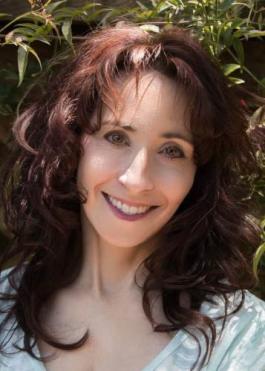By Laura López González

’Tis the season ... for stress. Between bright lights, airport security lines and fallen souffles, we are more overscheduled, overstretched and overwhelmed during the holiday season than at almost any other time of the year.
But there’s good news. We have much more control over stress and our emotions than we think, says UC San Francisco Professor of Psychiatry Elissa Epel, PhD. Epel’s book, The Stress Prescription: Seven Days to More Joy and Ease was recently named a favorite book of 2023 by Greater Good Magazine.
She explains how we can make taking control of our stress — and cultivating joy — a habit this holiday season.
What does stress do to our bodies?
We have looked at stress under the microscope, investigating how it can change our cells, right down to our telomeres — the “shields” at the ends of our chromosomes’ that protect the DNA inside. Telomere length is an important index of a cell’s health and ability to keep dividing. Telomeres naturally shorten with age, but chronic stress wears them out faster.
In short, when we’re too stressed for too long, it accelerates biological aging. Diseases like diabetes, heart disease and depression can develop or develop early.
What are micro-acts of wellness?
Micro-acts are quick practices of just a few minutes that can reduce stress and cultivate happiness, often involving focusing on the beauty and joy in life. People who performed just one micro-act daily for a week reported about a 25% increase in emotional well-being and feelings of connectedness to others, according to early results from a large, crowd-sourcing study we have conducted with colleagues at UC Berkeley. As part of the study, more than 20,000 people from 30 countries tried a micro-act for five minutes each day for one week. Anyone can join.
Why are micro-acts so powerful?
When we see that we can do something for just a few minutes, and that it can change how we feel, we actually alter our belief about our capacity to control our wellness. We call this a growth mindset: We increase our confidence in our ability to have some control over our well being. This new mindset, in turn, has a potent effect on whether we’re likely to make micro-acts a habit or not.
What are some examples of micro-acts?
Do something kind for someone. Think of people you might see today and list one thing you could do to brighten their day. For example, during the holidays it’s incredibly powerful to reach out to people we suspect don’t have friends, local family or social plans.
Tune in to what matters. Choose three values in your life — for example, kindness, community and social justice — and think of an example of how you are living them. Make a plan of how you want to embody one of them more in the coming year.
Reframe your perspective. Recall a recent moment when you felt upset and frustrated. Think about or write out three positive things about that experience. Focusing on the hidden positives is powerful. It can lessen your painful narrative of what happened.
The holidays are stressful, there are more demands on us, and we set higher expectations for how the holidays should go. But this is also an opportunity to realize the joy inherent in holiday stress and that it’s a privilege to be able to take time away from work to reflect and relax.
Breathe. People have used various breathing practices for millennia to energize, relax and even create ecstatic states.
Here’s a slow breathing technique that can calm our body immediately.
- Try sitting up straight with your chest up, chin down.
- Breathe slowly and gently with your mouth closed, drawing a deep breath into your diaphragm.
- Breath in for four seconds and out for six seconds for maximal stress release.
Meditate. Meditation has long been a part of my stress-management plan, both short daily practices and, when I am lucky, overnight retreats. Consider planning a retreat in 2024, for a deeper recalibration of your nervous system. There are many local opportunities in the Bay Area.
Dwell in awe. Watch an awe-inspiring video or, if possible, get out in nature. Make it a point to stop and marvel at the trees or views, feel the temperature of the air on your skin and listen to the birds chirping. If you don’t have a lot of nature near you, there’s always sky.
Our bodies are not only very attuned to having a relaxation response to nature, but increasing research shows that awe is a transformative emotion — the feeling of being in the presence of and part of something larger than oneself can snap things into perspective for us. When we are reminded of the world’s grandeur, personal issues that seemed large and looming may suddenly shrink.
If you can’t get out into nature, set up a quiet, comfortable “chill” space at home and search YouTube or Spotify for your favorite relaxing music with nature sounds.
Expose yourself to positive stress. When we are exposed to short-term manageable positive stressors, called hormetic stress, our body turns on different responses than it does with chronic stress. During our recovery period from hormetic stress, good things happen. It has an anti-anxiety effect on our nervous system, and an anti-aging effect in our cells. Hormetic stress triggers processes akin to cleaning crews gobbling up waste from the day’s metabolic processes and recycling it.
To create positive stress, try a quick seven-minute high-intensity exercise or take an ice-cold shower: After the ice-cold shower, wrap up in a warm towel: Stress then recover and relax. It feels good, and it’s good for our cells.
Make a gratitude list. List anything, big or small, you feel grateful about. Gratitude is one of the most potent ways to increase positive emotions. For a bigger boost, tell someone how much you appreciate them.
Celebrate another’s joy. Ask someone to tell you about something good that happened to them recently or about something they are happy about. “What made you smile today?” Let them tell the story. You will find their happiness is re-ignited, and you may smile too!
How can we make micro-acts a habit?
- Notice how it feels after you’ve completed a micro-act. Savor any positive feelings.
- Set aside a time each day to pause for a wellness micro-act. Put a reminder on your daily calendar and a Post-it note in the place where you want to practice it.
- Try “stapling” micro-acts to another habit you already do. For example, try two minutes of slow breathing while you start your commute or before you turn off your light at night.
About UCSF Psychiatry and Behavioral Sciences
The UCSF Department of Psychiatry and Behavioral Sciences and the Langley Porter Psychiatric Institute are among the nation's foremost resources in the fields of child, adolescent, adult, and geriatric mental health. Together they constitute one of the largest departments in the UCSF School of Medicine and the UCSF Weill Institute for Neurosciences, with a mission focused on research (basic, translational, clinical), teaching, patient care, and public service.
UCSF Psychiatry and Behavioral Sciences conducts its clinical, educational, and research efforts at a variety of locations in Northern California, including the UCSF Nancy Friend Pritzker Psychiatry Building; UCSF Langley Porter Psychiatric Hospital; UCSF Medical Centers at Parnassus Heights, Mission Bay, and Mount Zion; UCSF Benioff Children’s Hospitals in San Francisco and Oakland; Zuckerberg San Francisco General Hospital and Trauma Center; the San Francisco VA Health Care System; UCSF Fresno; and numerous community-based sites around the San Francisco Bay Area.
About the UCSF Weill Institute for Neurosciences
The UCSF Weill Institute for Neurosciences, established by the extraordinary generosity of Joan and Sanford I. "Sandy" Weill, brings together world-class researchers with top-ranked physicians to solve some of the most complex challenges in the human brain.
The UCSF Weill Institute leverages UCSF’s unrivaled bench-to-bedside excellence in the neurosciences. It unites three UCSF departments—Psychiatry and Behavioral Sciences, Neurology, and Neurological Surgery—that are highly esteemed for both patient care and research, as well as the Neuroscience Graduate Program, a cross-disciplinary alliance of nearly 100 UCSF faculty members from 15 basic-science departments, as well as the UCSF Institute for Neurodegenerative Diseases, a multidisciplinary research center focused on finding effective treatments for Alzheimer’s disease, frontotemporal dementia, Parkinson’s disease, and other neurodegenerative disorders.
About UCSF
The University of California, San Francisco (UCSF) is exclusively focused on the health sciences and is dedicated to promoting health worldwide through advanced biomedical research, graduate-level education in the life sciences and health professions, and excellence in patient care. UCSF Health, which serves as UCSF’s primary academic medical center, includes top-ranked specialty hospitals and other clinical programs, and has affiliations throughout the Bay Area.






